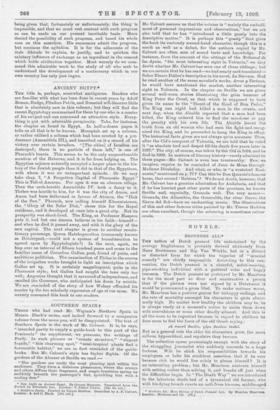SOUTHERN SPAIN.f Twigs who had read Mr. Wigram's Northern Spain
in Messrs. Black's series, and looked forward to a companion volume from the same pen; will be disappointed. The text of Southern Spain is the work of Mr. Culvert, It is, he says, " intended partly to supply a guide-hook to this part of the Peninsula" (to supplement, we presume, the writings of Ford): In such phrases as "ornate structure," "elegant façade," "this charming spot," "semi-tropical plants find a favourable habitat," we are in fact reminded of the guide- books. But Mr. Calvert's style has higher flights. Of the gardens of the Alcazar at Seville we read The gardens are really the most pleasing spot within the enclosure. They form a delicious pleasaunce, where the orange and citron diffuse their fragrance, and magic fountains spring up suddenly beneath tho passenger's feet, sprinkling him with a cooling dew."
• New Light on Ancient Egypt, By George Maspero. Translated from the French by Elizabeth Lee. London : T. Fisher Unwin. [12e. tkl, net.] t Southern Spain. Painted by Trevor Haddon. Described by A. F. Calvert. London: A. and C. Inms. Vas. net.] Mr. Calvert assures us that the voltime is " mainly'the embodi: ment of personal. impressions and observations," but we are also told that he has " introduced a little gossip into the descriptive matter." It is perhaps this " gossip " that gives the book its curiously second-hand character, though this is a merit as well as a defect, for the authors copied by Mr. Calvert are often men of sound taste and knowledge. For instance, from the account of the sittings of the Tribunal de las Aguas, "the most interesting sight in.Valencia," we may doubt whether Mr. Culvert has seen one of these 'sittings ; but we are certain that he has read—we had nearly said translated- Seflor Blasco Ibiliez's description in his novel, La Barraea. Had he read another of the same novelist's works, Arroz y Tartana, he would have meutioned the market, another interesting sight in Valencia. In the chapter on Seville we are given several well-worn stories illustrating • the grim humour of King Peter the Cruel, as that which is supposed to have given its name to the "Street of the Head of Don Pedro." The King one night had killed a man. in the streets, and next day, when the Alcalda reported that a man had been killed, the King ordered him to find the murderer or pay the penalty with his own life. The Alcalde learnt the truth from an old woman who had seen the fight and recog- nised the King, and he proceeded to hang the King in effigy. The historical facts given are not always quite accurate. Thus, after the Cid's conquest of Valencia, we are told that he ruled it "as absolute lord and desPot till his death five years later in 1097." The city, of course, was taken by the Cid in 1094, and he died in 1099. In matters of literary history—rarely admitted to these pages—Mr. Calvert is even less trustworthy.' Few, we imagine, require to be reminded of Juan de Mena through' Madame Dieulafoy. And what, or who, is "a wretched • Reg- nante," mentioned on p. 77 P Can this be Don Quixote's famous horse, that second • Babieca 'P We do not doubt, however, that Mr. Calvert has a genuine admiration for Andalucia, and that if be has hurried past other parts of the province, he knosys Seville and, especially, Granada well. The very names— Granada, the Alhambra, the Generalife, the river Darro, the Sierra del Sol—have an enchanting music. The illustrations of this and other famous cities painted by Mr. Trevor Haddon are often excellent, though the colouring is sometimes rather crude.









































 Previous page
Previous page